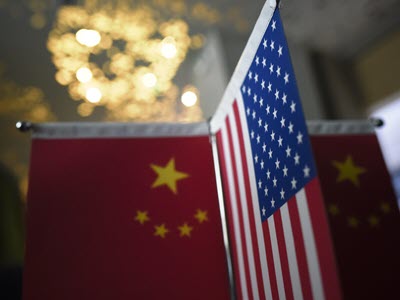Countering PRC Coercion as a Pathway for U.S. Economic Leadership
Jonathon Marek and Jerome Siangco examine the implications of PRC coercion for areas of critical importance to the U.S. economy and consider steps that Congress could take to mitigate the impact on U.S. companies as well as U.S. allies and partners.
Corporations based in the United States with operations in the People’s Republic of China (PRC) consistently face the threat of economic coercion. Companies ranging from the NBA to American, Delta, and United to Walmart have faced coercion over statements or actions related, respectively, to protests in Hong Kong, the status of Taiwan, and compliance with U.S. law against using products made with forced labor in Xinjiang. The Chinese Communist Party (CCP) sees any statement or action related to these topics as a threat to the PRC’s core interests and therefore elicits an often aggressive response. Economic coercion has included organizing boycotts against foreign corporations, limiting access to the PRC market, and codifying requirements for foreign corporations to abide by inconsistent CCP standards. Additionally, as Sino-U.S. strategic competition intensifies, it is to the PRC’s advantage to punish U.S. corporations to directly impose costs on the United States. These costs include risks to U.S. jobs and supply chains, as well as broader attacks on the competitiveness of U.S. companies relative to companies that do not face such coercive pressure.
The Problem
Because coercion touches on areas of critical importance to the U.S. economy at large, it is not just a problem borne by the individual companies in question, but rather a policy question with impacts on critical issues for Congress. Additionally, coercion touches on a common quandary for the United States in its economic competition with the PRC—namely, that the PRC’s control over its economy, including private sector companies, gives it access to an asymmetric toolkit to bring to bear against U.S. corporations. As such, congressional action is necessary to impose costs on the PRC for its exploitation of the open nature of global supply chains and level the playing field.
Current measures to counter PRC economic coercion are largely ineffective. As a result, corporations often must weigh how beneficial the PRC market value is to their bottom line against concerns over a wider consumer base beyond the PRC. Many of these corporations find that, while small-scale shifting of supply chains out of the PRC is possible, the PRC market is too lucrative and too costly to exit altogether, especially in the short term. The corporate response to the Russian invasion of Ukraine provides one example of businesses ceasing operations in a foreign country; however, Russia’s market is not the PRC’s, and it is unclear that corporations will ever vacate a valuable market short of war.
Therefore, U.S., allied, and partner governments must craft more effective policy to help corporations stand up to PRC economic coercion. Ambitious proposals such as an “Economic Article 5” are overly optimistic. Countries, like corporations, weigh the impact that such a proposal and the resulting PRC retaliation would have on their domestic environment. It is unlikely that many partners would agree to even begin negotiating such a framework with no promise of success, since such an agreement would provoke the coercion they seek to avoid.
A solution is needed now because PRC economic coercion will only continue to grow and more gravely affect U.S. and foreign corporations and governments. Together with long-term coordination with its allies and partners, the United States must lead in crafting a response and be willing to shoulder a majority of the PRC’s retaliation. Over time, as the U.S. response proves effective in working with U.S. corporations and countering the PRC, allies and partners can follow suit.
Options for Congress
As noted above, congressional action is necessary to address the problem of PRC economic coercion. First, Congress could take steps to mitigate the short-term costs for U.S. businesses. Few supply chains are so dependent on PRC inputs as to be completely unshiftable over time, and few corporations are incapable of finding alternative markets; however, many would face unbearable costs if forced to do so suddenly—the core challenge that the PRC exploits with its coercion.
Therefore, Congress could consider steps to ease targeted firms’ transition away from vulnerable markets and supply chains. Streamlining access to export credit, for example, could allow corporations coercively removed from PRC markets to find alternatives, while funding reshoring efforts for firms coercively cut off from PRC suppliers could offset the costs of shifting supply chains on short notice. To mitigate the potential of incentivizing firms to remain dependent on PRC supply chains up until when they face coercion, such funding could be conditioned on the U.S. firm having taken steps to diversify its supply chains and thereby mitigate its dependence on the PRC prior to any coercion. This conditionality would directly flip the incentive structure, aligning U.S. policy and corporate interests behind taking immediate steps to mitigate dependencies on the PRC and therefore the risk of coercion.
Second, beyond efforts to support businesses targeted by coercion, Congress could consider imposing targeted countermeasures on PRC individual and corporate entities directly engaged in economic coercion. Since most cases of coercion are acknowledged by PRC media, and their magnitude is discernable from trade data, any mechanism for a presidential determination that coercion is ongoing (such as that provided in the recently introduced Countering Economic Coercion Act), coupled with the identification of individuals and companies involved, would sufficiently identify targets.
The sanctions approach adopted in the Protecting American Intellectual Property Act of 2022 represents a roadmap. Its “sanctions menu”—the requirement that the president impose several sanctions from a list—allows for either limited or extensive countermeasures (ranging from visa bans to full-blocking sanctions). This means that responses can be proportionate while also targeting the core activities of the relevant PRC entities. Sanctions are thus preferred to tariffs, for instance, because they can cover a wider range of PRC actors, are more easily scalable, and directly target individuals and corporations engaged in malign behavior. Analysis by NBR’s IP Commission found that such sanctions are more effective in punishing or deterring this behavior than broader measures.
This unilateral approach runs counter to the consensus behind proceeding only in conjunction with allies and partners—as reflected in the discussions of an Economic Article 5. It is preferred since the United States has the economic heft, strong sanctions capabilities, and political will to withstand PRC pushback in a manner that many potential partners do not—and the PRC knows this. While the PRC has acted aggressively against individual corporations and small nations for minor slights, it has not proportionately retaliated against the United States as a whole over policy measures (e.g., U.S. sanctions against Huawei or semiconductor export controls).
Third, Congress could enact the Countering Economic Coercion Act and work to multilateralize the U.S. counter-coercion framework. The above discussion of sanctions is not to say that measures against PRC economic coercion should be designed exclusively to operate unilaterally; nor does the focus of this brief on coercion against U.S. companies imply that the United States does not have a national interest in preventing PRC coercion against allies and partners. Nonetheless, it is important to acknowledge the improbability that countries will agree to extensive negotiations and risk backlash from the PRC without any guarantee of success. In contrast, once a strong U.S. counter-coercion framework is in place, countries will likely seek to join on and be covered by a U.S. “economic umbrella”—much as allies value being protected by a U.S. defense commitment.
The Countering Economic Coercion Act represents a pathway toward such an “economic umbrella.” Acknowledging the caveat mentioned above that targeted sanctions are likely a more effective countermeasure than a broad tariff-based approach, the passage of this law—complemented by measures to protect U.S. firms as outlined above—could provide the necessary cover to allow U.S. allies and partners to develop their own counter-coercion frameworks with less fear of PRC retaliation.
Jonathon Marek is a Project Manager with the Center for Innovation, Trade, and Strategy at the National Bureau of Asian Research.
Jerome Siangco is a Project Manager with the Political and Security Affairs group and the Next Generation and Fellowship Programs at the National Bureau of Asian Research.
The views expressed are those of the authors.



